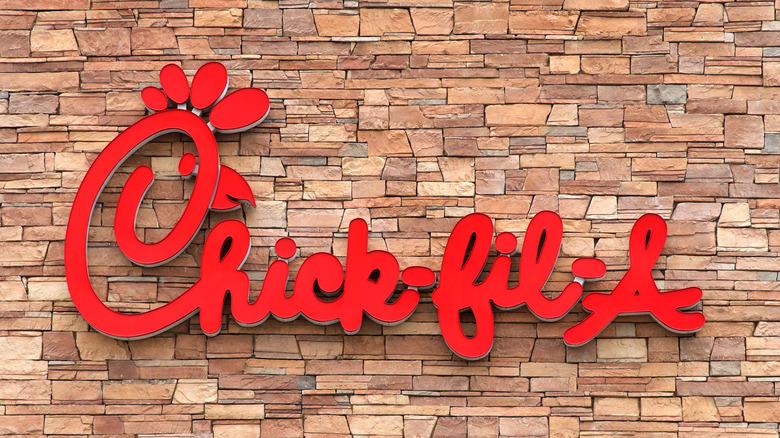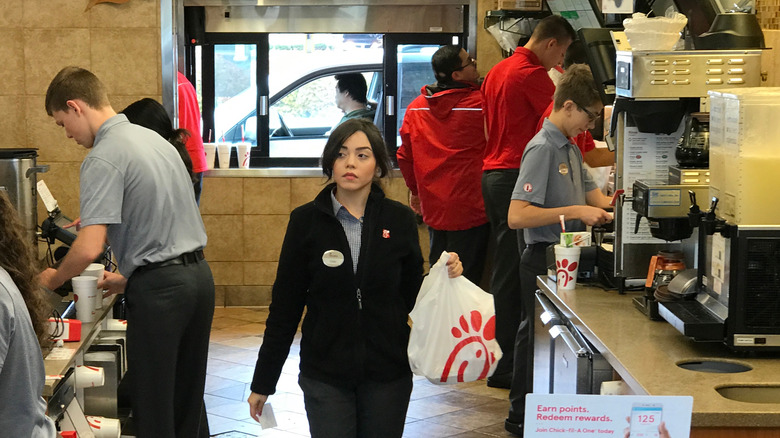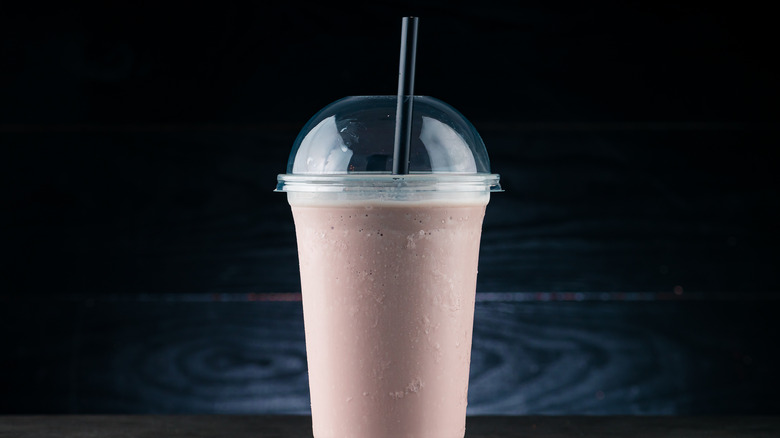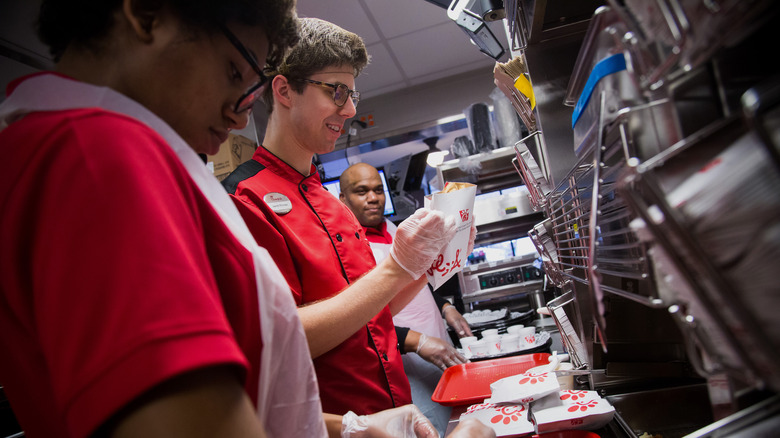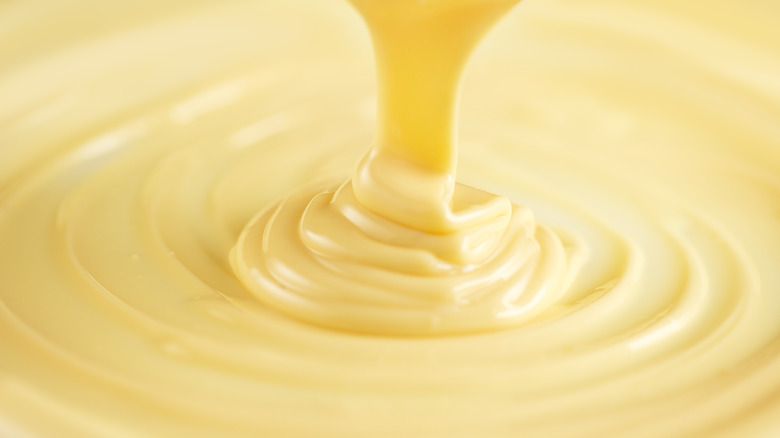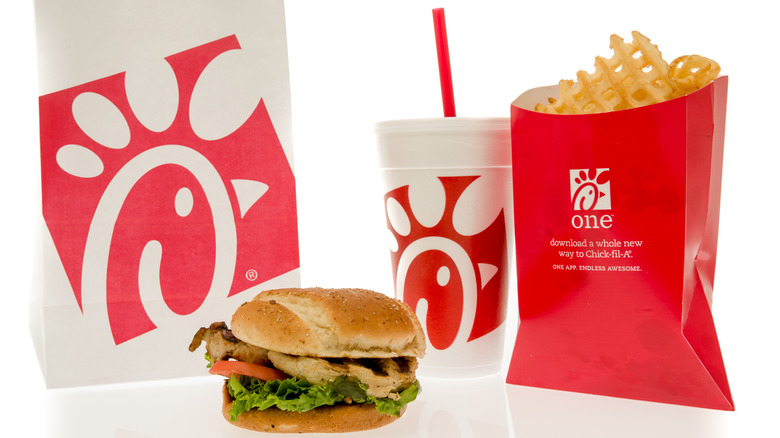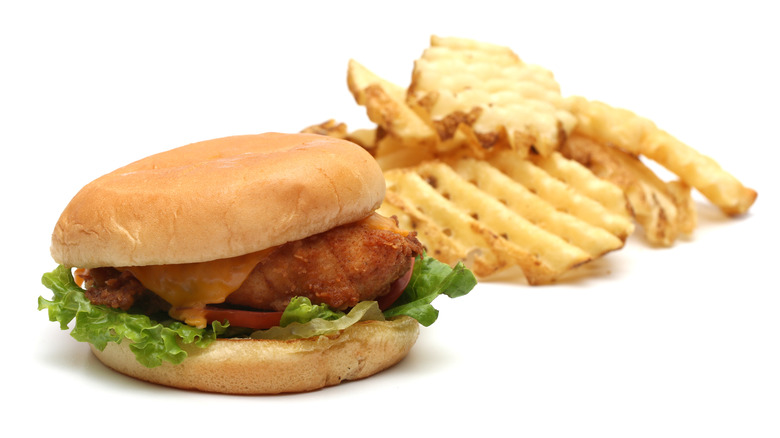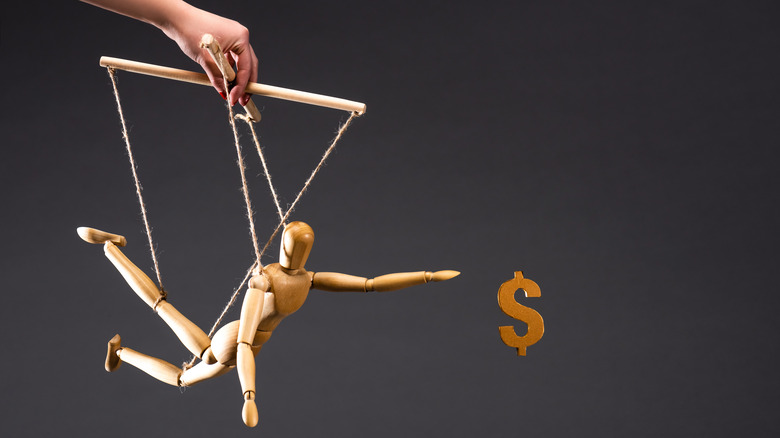We Finally Know Why Chick-Fil-A Is So Cheap
Founder S. Truett Cathy opened the doors of the first Chick-fil-A in 1967, and it has steadily expanded to become the largest fast food chicken restaurant in the United States. Its thick and juicy fried chicken sandwich with pickles on a buttered bun raised the bar for the fast food industry, revved up the "chicken sandwich wars," and became an American icon in the process.
While many restaurants have been struggling and going out of business throughout the pandemic (via Time), Chick-fil-A is not only surviving, but thriving. A look a QSR's top 50 fast-food chains shows that not only is Chick-fil-A in the top three, but Chick-fil-A also makes more money per restaurant than any other chain on the list. And yet it somehow manages to accomplish this while being closed every Sunday and keeping its prices affordable. Most of Chick-fil-A's sandwiches will only set you back a fiver, and you can even score a hand-spun milkshake for just a couple bucks (via Fast Food Menu Prices). How does Chick-fil-A do it? If you're wondering what Chick-fil-A's secret is, look no further: We finally know why Chick-fil-A is so cheap.
It pays low wages
Chick-fil-A has more than 140,000 hourly employees working hard behind the scenes to make sure that all of us get our fix of fried chicken. Without them, Chick-fil-A's entire operation would crumble, production would screech to a halt, and you'd never get to dunk Chick-fil-A's nuggets into their signature sauce ever again. And Chick-fil-A's labor force is incredibly productive – the average Chick-fil-A store outside of mall locations made over $7,000,000 in 2020. Like many businesses, however, Chick-fil-A doesn't seem to put very much of those earnings back into its labor force.
The average hourly wage across the entire U.S. population comes out to just over $16 per hour (via Statista). According to Payscale, Chick-fil-A pays an average hourly wage of $11.77 — well below the average. By paying much of its workforce below-average wages, Chick-fil-A keeps labor costs down and menu prices low while maximizing profit.
The milkshakes don't have any ice cream
There's something special about drinking a milkshake while you're eating crispy food like fried chicken and french fries. The creamy sweetness of the milkshake perfectly compliments the salty crunch of the food, harmoniously stimulating polar opposites of the palate. Chick-fil-A's milkshakes come in a variety of classic flavors like vanilla, chocolate, cookies and cream, and strawberry, along with occasional seasonal flavors. But ice cream is fairly pricey these days, so how is it that Chick-fil-A can sell its milkshakes for a few bucks a pop and still turn a profit? We hate to burst your milkshake bubble, but Chick-fil-A doesn't use real ice cream.
Chick-fil-A uses "Icedream" as the main ingredient in its milkshakes and its cones. But what is it made out of? Looking at the nutritional labels on Chick-fil-A's menu online shows that it's mostly milkfat, sugar, artificial flavorings, thickening agents, and water. Though a lower fat content makes "Icedream" a little healthier, it doesn't have enough fat to technically qualify as ice cream. In other words, Chick-fil-A's "Icedream" mimics the texture and flavoring of ice cream, but isn't the real stuff. By using artificial ice cream, Chick-fil-A keeps the price of its frozen sweet treats nice and low.
Chick-fil-A retains its staff
Even though Chick-fil-A pays relatively low wages, it still manages to keep much of its staff long-term. This is an important point, because a constant revolving door of new employees tends to be very expensive for businesses, according to The Balance Careers. Turnover costs start to pile up when you factor in hiring expenditures, pre-employment screening processes, training time, lower production rates, and extra administrative processing.
Fortunately for Chick-fil-A, the rate of turnover for its franchisors is very low — amazingly, the retention rate has hovered around 95% for 50 years (via Franchise Business Review). The same is true for hourly workers, who have a turnover rate of 60%, which is much lower than the national industry average (via Work Stream). Through benefits like its scholarship program, which provides employees with up to $25,000 in tuition assistance, Chick-fil-A incentivizes staff to stay long-term (via Restaurant Business). By investing in its employees through programs, Chick-fil-A is seeing the bigger picture. Keeping the rate of employee turnover low allows the company to maintain high production and low prices.
It uses butter-flavored oil
Much like its artificial rendition of ice cream, Chick-fil-A uses a similar tactic for it's cooking fat, using "butter-flavored oil" instead of authentic butter. Because real butter tends to be pricey, finding an alternative is a good way to for the company to save money — and the taste is very similar. Chick-fil-A uses its butter-flavored oil on lots of its menu items, including its chicken sandwiches, hash brown scramble bowls, and sausage, egg, and cheese biscuits. But what's in this stuff, exactly?
Taking a peek at some of the nutritional labels through the menu on Chick-fil-A's website shows its butter-flavored oil is a mix of soybean oil, palm kernel oil, soy lecithin, natural flavor, and beta-carotene. According to Scientist Live, beta-carotene is used extensively throughout the food industry as a food coloring. In all likelihood, that shade of yellowish orange you spot on Chick-fil-A's food that gives the illusion of butter is really just beta-carotene floating in oil. Using artificial butter instead of the real stuff is clearly a calculated move to keep prices low.
Meal deals aren't really a bargain
When it comes to fast food, we often believe that we're getting a better deal than we really are. For example, when you take a look at the spicy chicken sandwich on Chick-fil-A's menu, you'll notice that the price of the sandwich is around four bucks. For just a few more bucks, you can make the sandwich a "meal" by adding a side and a drink. If you choose fries and a soda, as many people do, then you're really just getting suckered out of more money in exchange for some of the restaurant's most profitable items.
According to Motley Fool, soft drinks are often sold at restaurants for up to a 90% profit margin. French fries also rake in serious cash and can offset other costs because of their high profit margin (via Ferraro Foods). Odds are, what you are paying several dollars for only cost Chick-fil-A some spare change to serve. Because the profitability of soda and sides is so high, Chick-fil-A can keep their meal price relatively low but still make a high percentage of profit on that sale.
Improved drive-thru experience
In an effort to increase sales and production flow, Chick-fil-A has made serious investments to improve its drive-thru experience for customers. One important part of that effort is the formation of the Chick-fil-A Drive-Thru Innovation Team. According to Chick-fil-A, the team's mission is to ensure smooth and timely transactions throughout the drive-thru experience. In order to accomplish this, the team actually tests out transactions with real customers at Chick-fil-A's full-scale drive-thru mockups in Atlanta. Chick-fil-A has also invested in tablets to help team members relay orders to the kitchen, and has constructed extra drive-thru lanes at some locations so that they have the capacity to handle bigger crowds.
According to QSR Magazine, the pandemic triggered an increased demand for drive-thru and take-out options, which presents opportunities for more revenue. By investing in better drive-thrus, Chick-fil-A is adapting to changes in the market and producing lucrative long-term results.
Inexpensive ingredients
In order to keep menu prices cheap, Chick-fil-A has to ensure that the ingredients themselves are inexpensive and then mark them up for a profit. According to Forbes, restaurants typically mark up ingredients around 300% in order to make a profit. To illustrate this, Forbes breaks down the price of different menu items like sandwiches and salads, showing the approximate cost of ingredients followed by how much a restaurant would generally charge for the item.
One of these examples is for a cobb salad, which is an item that Chick-fil-A offers on their menu. According to Forbes, if the real cost for a cobb salad is $3.45, a restaurant will probably charge a customer about $12.00 for it, which comes out to a 248% markup. Applying the same 248% markup to Chick-fil-A's cobb salad that they charge about nine bucks for, it's fair to assume that the actual cost of the cobb salad to Chick-fil-A is around $2.59. That means when you pay $9.00 for a salad at Chick-fil-A, about $6.41 goes right into the company's pocket. By using inexpensive ingredients, Chick-fil-A can keep menu prices low, mark up the price, and turn a handsome profit.
Our perception of cheap is warped
Marketers make a living by finding effective ways to persuade you into spending your hard-earned money. A big part of that process is convincing you that you're getting a good deal — which means making you believe that the price tag of whatever you're buying is worth it. According to Psychology Today, one of these marketing methods is called the left digit bias, also known as "charm prices."
Ever notice that the vast majority of prices rarely end in zero? More often than not, prices will end in 99 cents. Why not just round up to the next dollar? Because we read from left to right, and seeing a smaller number first warps our perception of the price; this is the left-digit bias in action. For example, we are more likely to make a purchase when the price tag is $1.99 instead of two bucks, even though the price difference of a single penny is practically meaningless. But because we see that smaller dollar amount on the left first, that first digit manipulates our perception of the price, and we're more likely to make a purchase and feel like we're getting a good deal. Just like other businesses, Chick-fil-A uses the left-digit bias charm prices on its menu to entice consumers into spending their money. When you consider the real cost of ingredients, the significant profit margins, and understand the subtle psychology that affects your spending, it's easy to see that our notion of "cheap" is often just an illusion.
